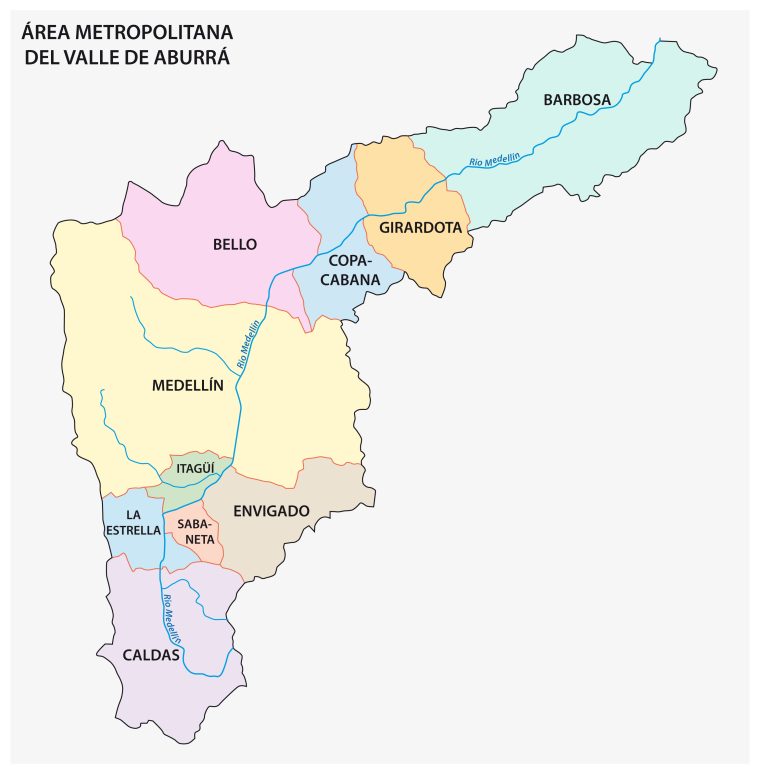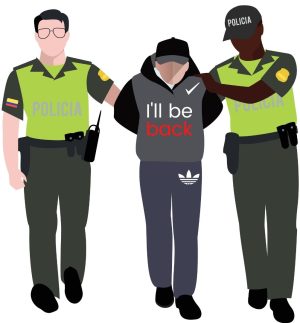This Is What Happens to Robbers in Medellin
For many thinking of, or already staying in Medellin, it’s one of our biggest fears; getting robbed is a nasty possibility. But, how about the robbers themselves? Is there any deterrent or are we living in a totally perverse society?
By Kaveh Paymayesh

Getting robbed. Mugged. Held up.
It’s a nasty prospect. So much so that it manages to govern a great deal of our behaviour. Many of our decisions are shaped by the reality of theft in Medellin; to traverse that quiet street or instead get a taxi, is it worth bringing this extra money out with me or not…?
But what about these blasted thugs? What exactly runs through their minds? Are they giving it a second thought? Is there enough peril to instil some fear, or at the least, circumspection before perpetrating their crimes?
What the figures indicate
…and yes, I know! We should take the data with a pinch of salt.
According to El Tiempo, in 2021, major cities in Colombia saw a worrying spike in both thefts and robberies. Unfortunately, this was to be expected as a consequence of national lockdowns.
The ‘official’ figures indicate that in Medellin almost all types of theft increased from 2020 to 2021. This isn’t year-end data but rather for 9 months:
- 13,977 armed robberies compared to 11,162 in the same period in 2020. An increase of 25%.
- 2,823 motorcycle thefts in 2021 compared to 2,641 in 2020. An increase of 7%.
According to the same source of data, the following types of theft decreased:
- Car theft cases dropped 10%.
- Shoplifting fell by 35%.
These figures are similar to those shared by El Colombiano. Accordingly, three types of theft increased in 2021:
- Armed robberies with 22,900 reported cases. An increase of 29%.
- Theft of cellphones (without force) with 12,145 cases. An increase of 6%.
- Theft of motorbikes with 4,383. An increase of 3%.
These two sources also agree that shop based robberies decreased. The percentage decrease given by El Colombiano is 32%.
Notable considerations
Have in mind that this data refers to incidents that happen specifically within Medellin. Therefore, this does not include the entirety of the Medellin Metropolitan Area.
For example, what happens in Bello, a large but separate municipality of over 533,000 inhabitants, is omitted from these figures. If it were to be included then figures would be higher.

Another consideration is that data is likely to be understated as a result of victims failing to denounce the crimes. I understand why people do this, but I’d implore all victims to report any crime that happens.
Sadly, there is a culture of indifference, caused by despair. To a large extent, citizens in South America feel that ineptitude make it pointless to report crime. However, Medellin is a developed city, arguably one of the most on the continent.
Campaigns desperately try to raise awareness on the importance and benefit of calling 123 – the emergency hotline.
I know that reporting crime is largely useless in many parts of Colombia, but I believe that this does not apply in Medellin.
The impact of social media
After many years of dealing with misinformation, there are many in Colombia that have grown sceptical of what they read from officials.
However, in this information age, it is a lot easier to share information that relates to crime and safety.
There are non-government social media channels dedicated to denouncing crimes. The sentiment of these channels is in agreement with the findings of the official reports: crime and theft have increased!
Many Paisas have been galvanized into action after feeling inadequately protected by the state. They grow tired of being victimized by delinquents.
If you want to be savvy to local crime, then there are social media groups you can follow. Be advised that:
They are explicit.
On Instagram, search Rolando Plazas.
How many robbers get caught?
This is the golden question. The answer to which is elusive.
Bringing crooks to justice has long been a major challenge in Colombia. It seems that every step of the process is ridden with issues, from the initial crime investigation all the way up to the sentencing in the courts.
Medellin, whilst still prone to the same challenges, is miles ahead of its neighbouring cities. In my opinion, the Metropolitan Police of the Aburra Valley, through their historic hardships, have evolved to become the most competent police force in the country.
Nationally, Medellin possesses some of the best resources required to prevent and detect crime. Things like CCTV, ‘smart’ cameras, crime response teams, etc. Even the oversight of policing is good, meaning that you’ll often hear about corrupt officers getting caught & fired. It’s all going in the right direction.
I mean, they even have DJI drones in the sky. We don’t get that in London!
In February of 2021, Medellin launched the operation, Escuadron Antifleteo (Anti-robbery Squad). With technological support and over 90 personnel, the sole function is to combat theft; everything from identification, capture to prosection.
By the end of the year, this group alone captured 110 robbers…
Presentamos el Escuadrón Antifleteo en Medellín. 70 hombres de la Policía, helicóptero, drones, cámaras, inteligencia artificial y reconocimiento facial para dar un duro golpe al fleteo en la ciudad. pic.twitter.com/oy49t70wIk
— Daniel Quintero Calle (@QuinteroCalle) February 9, 2021
Whilst commendable, let’s not forget that this didn’t stop the prevalence of robberies from increasing. This result is a mere dent. A drop in the ocean sadly. Remember, if we conservatively say that there were 10,000 armed robberies in Medellin for 2021, then only 1.1% would have been caught by this dedicated response team. Sad.
Looking on the brighter side, the number of robbers getting caught is increasing.
In my opinion, the police aren’t to blame. They’re actually doing a good job. It’s that they simply can’t compete with the ubiquity of those that resort to crime.
On social platforms run by the Alcalde de Medellin, regular updates show different thieves and robbers in police custody. They perpetuate catchphrases such as “criminals don’t have it easy in Medellin” & “Medellin mas seguro”.
Unlike in many other parts of Colombia, it is clear that the state is making concerted efforts to deal with robbers.
What happens to robbers in Medellin?
Based on the figures provided alone, we can say that the majority of robbers in Medellin do not get caught! On the other hand, we can also infer that things are improving in this respect, thanks to a concerted effort not only by the police but by citizens who are increasingly reporting crimes. There’s room for optimism.
The real problem at hand
The big problem at hand is the Colombian justice system. Whether or not robbers get caught, they will likely avoid paying for their crimes.
Disturbingly, this is beyond the control of the police. Despite their efforts, which are increasingly fruitful, it is not uncommon for thieves to be released after little to no time in custody. This spells IMPUNITY for many of Medellin’s delinquents.
Did you know that one particular thief in Medellin was captured and released 34 times?!
Furthermore, according to the Semana, the majority of criminals brought before the courts do NOT face jail. In 2016, of the 245,528 delinquents captured, just 10,000 of them were sent to jail, with a further 3,000 under house arrest.
This means that less than 20% of all captured criminals make it to prison.
Four things are very clear:
- The police are doing their job
- The judicial system is not
- Systemic change is required
- The law is no deterrent for robbers in Medellin

The judicial system in Colombia has major shortcomings. Without fear of the state, criminals become emboldened and brazen. Robbers have been granted their power by loopholes and errors within the legal system.
But here’s the thing:
Power creates its own resistance.
Fighting back - literally.
Street justice. Vigilantism. Mobs. Whatever you want to call it…
What we are seeing throughout Colombia, especially Medellin, is the pueblo fighting back. Sick and tired of all the reoffending criminals, it’s not uncommon for robbers caught in the act to get justice served on the streets. A different brand of justice.
Although I do not condone violence, it’s hard not to sympathize with the despair that normal people feel. Watch this clip of an unlucky armed robber:
What I see in that video, other than a robber immediately receiving his comeuppance, is a community of people looking out for one another. Call me sick, but that elicits goosebumps.
Again, to answer the question of this article:
If robbers are fortunate enough, they’ll have a public meeting/QandA with their fellow citizens.
And I’ll tell you what, that kind of outcome is MUCH more likely to make a robber think twice than if he were to be arrested and seen before a judge.
Here are some more videos of robbers in Medellin getting thwarted and disciplined by the public.
WARNING: Explicit imagery depicting scenes of violence.
What do you think? Do robbers in Medellin have it easy?
Facebook
Twitter
LinkedIn
Reddit